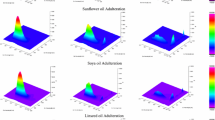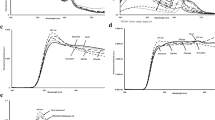Abstract
Sesame oil (SO) is a high-quality and very popular edible oil with pleasant odor and good taste, which has higher economic and nutritional value than other common vegetable oils. However, there is no effective and standardized method for detecting adulterated sesame oil, so there is an urgent need to develop a rapid and effective method for the detection of adulterated sesame oil. In this work, a strategy based on the excitation-emission matrix (EEM) fluorescence spectroscopy combined with multi-way chemometric methods was proposed to distinguish the plant origin of vegetable oils, identify adulterated sesame oil and quantify the level of adulteration of soybean oil (SBO) in SO. Three kinds of multi-way chemometric methods were used in this work. They are alternating trilinear decomposition coupled with partial least squares discriminant analysis (ATLD-PLS-DA), multilinear partial least squares discriminant analysis (N-PLS-DA) and unfolded partial least squares discriminant analysis (U-PLS-DA). The total recognition rates (TRRs) of plant origin of edible oils for the testing set were 79.17%, 100% and 100%, respectively, based on ATLD-PLS-DA, N-PLS-DA and U-PLS-DA model. For the identification of adulterated sesame oil, the TRRs for the testing set were 93.10%, 100% and 100%, respectively. What’s more, N-PLS regression and U-PLS regression were used for predicting the adulteration amount of SBO in SO. Satisfactory prediction accuracy with RMSEV = 2.74% was obtained by U-PLS regression. Therefore, it can be concluded that EEM fluorescent fingerprint combined with multi-way chemometric methods is an effective strategy to classify the plant origin of vegetable oils, identify the adulteration of SO and quantify the level of adulteration.






Similar content being viewed by others
Data availability
The dataset analysed during the current study are available on a reasonable request.
References
Elleuch M, Bedigian D, Zitoun A (2011). In: Preedy VR, Watson RR, Patel VB (eds) Nuts and seeds in health and disease prevention. Academic press, San Diego, pp 1029–1036
Langyan S, Yadava P, Sharma S, Gupta NC, Bansal R, Yadav R, Kalia S, Kumar A (2022) Food and nutraceutical functions of sesame oil: an underutilized crop for nutritional and health benefits. Food Chem 389:132990
Firouz MS, Rashvand M, Omid M (2021) Rapid identification and quantification of sesame oils adulteration using low frequency dielectric spectroscopy combined with chemometrics. LWT Food Sci Technol 140:110736
Jabeur H, Drira M, Bouaziz M (2021) Targeted authentication approach for the control of the contamination of refined olive oil by refined seeds oils using chromatographic techniques and chemometrics models. Eur Food Res Technol 247(10):2455–2472
Hu Q, Zhang J, Xing R, Yu N, Chen Y (2022) Integration of lipidomics and metabolomics for the authentication of camellia oil by ultra-performance liquid chromatography quadrupole time-of-flight mass spectrometry coupled with chemometrics. Food Chem 373:131534
Li X, Wang D, Ma F, Yu L, Mao J, Zhang W, Jiang J, Zhang L, Li P (2023) Rapid detection of sesame oil multiple adulteration using a portable Raman spectrometer. Food Chem 405:134884
García MJF (2022) Potential of near-infrared spectroscopy for the determination of olive oil quality. Sensors 22(8):2831
Mannu A, Poddighe M, Garroni S, Malfatti L (2022) Application of IR and UV-VIS spectroscopies and multivariate analysis for the classification of waste vegetable oils. Resour Conserv Recycl 178:106088
da Silva Medeiros ML, Cruz-Tirado J, Lima AF, de Souza Netto JM, Ribeiro APB, Bassegio D, Godoy HT, Barbin DF (2022) Assessment oil composition and species discrimination of brassicas seeds based on hyperspectral imaging and portable near infrared (NIR) spectroscopy tools and chemometrics. J Food Compos Anal 107:104403
Maestrello V, Solovyev P, Bontempo L, Mannina L, Camin F (2022) Nuclear magnetic resonance spectroscopy in extra virgin olive oil authentication. Compr Rev Food Sci F 21(5):4056–4075
Omwange KA, Al Riza DF, Saito Y, Suzuki T, Ogawa Y, Shiraga K, Giametta F, Kondo N (2021) Potential of front face fluorescence spectroscopy and fluorescence imaging in discriminating adulterated extra-virgin olive oil with virgin olive oil. Food Control 124:107906
Ruisánchez I, Rovira G, Callao MP (2022) Multivariate qualitative methodology for semi-quantitative information a case study adulteration of olive oil with sunflower oil. Anal Chim Acta 1206:339785
Kaufmann KC, Sampaio KA, García-Martín JF, Barbin DF (2022) Identification of coriander oil adulteration using a portable NIR spectrometer. Food Control 132:108536
Johnson JB, Thani PR, Naiker M (2022) Detection of eucalyptus oil adulteration in Australian tea tree oil using UV–Vis and fluorescence spectroscopy. Talanta Open 6:100169
Cao J, Li C, Liu R, Liu X-R, Fan Y, Deng Z-Y (2017) Combined application of fluorescence spectroscopy and chemometrics analysis in oxidative deterioration of edible oils. Food Anal Method 10(3):649–658
Gonçalves TR, Teixeira GG, Santos PM, Matsushita M, Valderrama P (2023) Excitation-emission matrices and PARAFAC in the investigation of the bioactive compound effects from the flavoring process in olive oils. Microchem J 187:108360
Yuan L, Meng X, Xin K, Ju Y, Zhang Y, Yin C, Hu L (2023) A comparative study on classification of edible vegetable oils by infrared, near infrared and fluorescence spectroscopy combined with chemometrics. Spectrochim Acta A 288:122120
Yin X-L, Gu H-W, Liu X-L, Zhang S-H, Wu H-L (2018) Comparison of three-way and four-way calibration for the real-time quantitative analysis of drug hydrolysis in complex dynamic samples by excitation-emission matrix fluorescence. Spectrochim Acta A 192:437–445
Gu H-W, Zhang S-H, Wu B-C, Chen W, Wang J-B, Liu Y (2018) A green chemometrics-assisted fluorimetric detection method for the direct and simultaneous determination of six polycyclic aromatic hydrocarbons in oil-field wastewaters. Spectrochim Acta A 200:93–101
Hu L-Q, Zhang Y, Ju Y, Meng X-R, Yin C-L (2023) Rapid identification of rice geographical origin and adulteration by excitation-emission matrix fluorescence spectroscopy combined with chemometrics based on fluorescence probe. Food Control 146:109547
Meng X, Yin C, Yuan L, Zhang Y, Ju Y, Xin K, Chen W, Lv K, Hu L (2023) Rapid detection of adulteration of olive oil with soybean oil combined with chemometrics by fourier transform infrared, visible-near-infrared and excitation-emission matrix fluorescence spectroscopy: a comparative study. Food Chem 405:134828
Peng T-Q, Yin X-L, Sun W, Ding B, Ma L-A, Gu H-W (2019) Developing an excitation-emission matrix fluorescence spectroscopy method coupled with multi-way classification algorithms for the identification of the adulteration of Shanxi aged vinegars. Food Anal Method 12(10):2306–2313
Rahman MM, Bui MV, Shibata M, Nakazawa N, Rithu MNA, Yamashita H, Sadayasu K, Tsuchiyama K, Nakauchi S, Hagiwara T, Osako K, Okazaki E (2021) Rapid noninvasive monitoring of freshness variation in frozen shrimp using multidimensional fluorescence imaging coupled with chemometrics. Talanta 224:121871
Wu H-L, Shibukawa M, Oguma K (1998) An alternating trilinear decomposition algorithm with application to calibration of HPLC-DAD for simultaneous determination of overlapped chlorinated aromatic hydrocarbons. J Chemometr 12(1):1–26
Liu Z-Z, Gu H-W, Guo X-Z, Geng T, Li C-L, Liu G-X, Wang Z-S, Li X-C, Chen W (2022) Tracing sources of oilfield wastewater based on excitation-emission matrix fluorescence spectroscopy coupled with chemical pattern recognition techniques. Spectrochim Acta A 281:121596
Bro R (1996) Multiway calibration multilinear pls. J Chemometr 10(1):47–61
Hu X-C, Yu H, Deng Y, Chen Y, Zhang X-H, Gu H-W, Yin X-L (2022) Rapid authentication of green tea grade by excitation-emission matrix fluorescence spectroscopy coupled with multi-way chemometric methods. Eur Food Res Technol 293:1–9
Gu H-W, Yin X-L, Zhou X-C, Chen Y, Meng X-Z, Peng T-Q (2020) Impact of diverse background interferences on the alternating trilinear decomposition modeling of excitation-emission matrix fluorescence data acquired from different sample sources. Spectrochim Acta A 232:118173
Wold S, Sjöström M, Eriksson L (2001) PLS-regression: a basic tool of chemometrics. Chemometr Intell Lab 58(2):109–130
Smilde AK (1997) Comments on multilinear PLS. J Chemometr 11(5):367–377
de Jong S (1998) Regression coefficients in multilinear PLS. J Chemometr 12(1):77–81
Bro R, Smilde AK, de Jong S (2001) On the difference between low-rank and subspace approximation: improved model for multi-linear PLS regression. Chemometr Intell Lab 58(1):3–13
Arancibia JA, Boschetti CE, Olivieri AC, Escandar GM (2008) Screening of oil samples on the basis of excitation-emission room-temperature phosphorescence data and multiway chemometric techniques introducing the second-order advantage in a classification study. Anal Chem 80(8):2789–2798
Bahram M, Bro R, Stedmon C, Afkhami A (2006) Handling of Rayleigh and Raman scatter for PARAFAC modeling of fluorescence data using interpolation. J Chemometr 20(3–4):99–105
Ali H, Saleem M, Anser MR, Khan S, Ullah R, Bilal M (2018) Validation of fluorescence spectroscopy to detect adulteration of edible oil in extra virgin olive oil (EVOO) by applying chemometrics. Appl Spectrosc 72(9):1371–1379
Sikorska E, Romaniuk A, Khmelinskii IV, Herance R, Bourdelande JL, Sikorski M, Kozioł J (2004) Characterization of edible oils using total luminescence spectroscopy. J Fluoresc 14(1):25–35
Ntakatsane MP, Liu X, Zhou P, Mothibe KJ, Adegoke GO, Odenya WO (2014) Characterization of fatty acid profile by FFFS. J Food Meas Charact 8:1–8
Tena N, García-González DL, Aparicio R (2009) Evaluation of virgin olive oil thermal deterioration by fluorescence spectroscopy. J Agric Food Chem 57(22):10505–10511
Wang T, Wu H-L, Long W-J, Hu Y, Cheng L, Chen A-Q, Yu R-Q (2019) Rapid identification and quantification of cheaper vegetable oil adulteration in camellia oil by using excitation-emission matrix fluorescence spectroscopy combined with chemometrics. Food Chem 293:348–357
Bro R, Kiers HAL (2003) A new efficient method for determining the number of components in PARAFAC models. J Chemometr 17(5):274–286
Sikorska E, Khmelinskii I, Sikorski M (2012) In: Boskou D (ed) Olive oil: constituents, quality, health properties and bioconversions. In: Tech, Rijeka Croatia, pp 63–88
Yuan Y-Y, Wang S-T, Wang J-Z, Cheng Q, Wu X-J, Kong D-M (2020) Rapid detection of the authenticity and adulteration of sesame oil using excitation-emission matrix fluorescence and chemometric methods. Food Control 112:107145
Acknowledgements
The authors would like to acknowledge the financial supports from the National Natural Science Foundation of China (Grant Nos. 32272409, 32001790), and the Natural Science Foundation of Hubei Province (Grant No. 2022CFB161).
Author information
Authors and Affiliations
Corresponding author
Ethics declarations
Conflict of interest
The authors declare that they have no known competing financial interests or personal relationships that could have appeared to influence the work reported in this paper.
Compliance with ethics requirements
This article does not contain any studies with human or animals and complies with ethical requirements.
Additional information
Publisher's Note
Springer Nature remains neutral with regard to jurisdictional claims in published maps and institutional affiliations.
Supplementary Information
Below is the link to the electronic supplementary material.
Rights and permissions
Springer Nature or its licensor (e.g. a society or other partner) holds exclusive rights to this article under a publishing agreement with the author(s) or other rightsholder(s); author self-archiving of the accepted manuscript version of this article is solely governed by the terms of such publishing agreement and applicable law.
About this article
Cite this article
Song, JY., Gu, HW., Wang, Y. et al. Excitation-emission matrix fluorescence spectroscopy combined with multi-way chemometric methods for rapid qualitative and quantitative analyses of the authenticity of sesame oil. Eur Food Res Technol 249, 2087–2099 (2023). https://doi.org/10.1007/s00217-023-04275-0
Received:
Revised:
Accepted:
Published:
Issue Date:
DOI: https://doi.org/10.1007/s00217-023-04275-0




